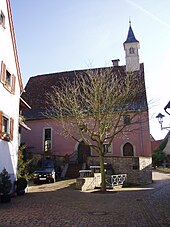Obergrombach Castle and Palace
| Obergrombach Castle and Palace | ||
|---|---|---|
|
Tower of the castle complex |
||
| Creation time : | around 1000 | |
| Castle type : | Höhenburg, spur location, local location | |
| Conservation status: | Preserved essential parts | |
| Standing position : | Noble | |
| Place: | Obergrombach | |
| Geographical location | 49 ° 4 '34.8 " N , 8 ° 35' 20.8" E | |
|
|
||
Obergrombach castle and palace are a landmark of Obergrombach and have been the residence of the von Bohlen and Halbach family for several generations .
investment
The ruins of the core castle from the 13th century are located on a mountain spur ( spur castle ) east of the center of Obergrombach. It has an oval floor plan and a kennel with several shell towers . The preserved 25 m high keep with a wall thickness of around 2.40 m and a square floor plan of 8 × 8 m is attached to the complex outside the mantle wall on the east side, i.e. uphill. The neck ditch is also on this side of the complex . Inside are the remains of two residential buildings.
History of the castle
The first castle complex was probably built around 1000 AD, but the successor to this first fortified property was not mentioned in a document until 1317; a castle in Grumbach , which has nothing to do with today's castle building, in 1256. The complex belonged to the Lords of Grombach first, and later, from 1311 to 1803, to the Prince-Bishops of Speyer, who used it to secure the southeastern border of their bishopric used. The former church of the village fell victim to an expansion of the castle at the end of the 14th or beginning of the 15th century, which was replaced by the later castle chapel . This was first mentioned in a document in 1401. The building of the four-story palace can be dated to the year 1461 .
The bishops Raban von Helmstatt († 1439) and Ludwig von Helmstatt († 1504) expanded the fortifications.
From 1464 to 1467, the Speyer bishop Johannes II. Nix von Hoheneck , who had resigned for political reasons and who had been given the castle for life when he resigned, lived here .
During the Thirty Years' War , the castle was attacked and taken by the Bishop of Sötern . In 1633 Colonel Schmidberg besieged Obergrombach Castle and in 1644 it was occupied by Major General Rossa. Part of the castle was later destroyed by French soldiers.
History of the castle
Damian Hugo von Schönborn had the castle building, which is still in use and preserved, erected in 1720–1723. Until 1803 it was used as a summer residence by his successors. Before it was acquired by Gustav von Bohlen und Halbach in 1885 , the approximately five hectare site including the buildings passed through the hands of members of the House of Baden, Lieutenant Leopold von Holzing, who had it restored in the mid-19th century, of Count Ferdinand von Normann-Ehrenfels, who had Schönborn's building redesigned in a romanticizing style, and three Barons von Weißenstein, who only owned the complex for three years, from 1882 to 1885.
Under the aegis of the von Bohlen and Halbach family
Three years later, von Bohlen und Halbach also acquired the local synagogue and turned it into a palace or castle chapel. In the castle he set up summer quarters for his family; the winters were spent in Karlsruhe . To this day, the property is owned by the family, who also set up a private cemetery there. From the family of Gustav Krupp von Bohlen and Halbach , Berthold von Bohlen and Halbach was buried here in 1987. The community named Gustav-von-Bohlen-Strasse and Sofienstrasse after the first owner couple from this family. After the Second World War, a public outdoor swimming pool was set up on the premises of the lord of the castle , which the current lord of the castle, Eckbert von Bohlen und Halbach, gave to the city a few years ago.
Obergrombach Castle and Palace can be viewed as part of the Open Monument Day or during castle festivals. The castle chapel, which cannot be heated because of the valuable frescoes , is used by the evangelical community in the summer. The paintings were apparently commissioned by Bishop Johannes II. Nix von Hoheneck († 1467), as indicated by the coat of arms preserved here.
Individual evidence
- ^ Franz Xaver Remling : History of the Bishops of Speyer , Volume 2, Mainz, 1854, p. 137; (Digital scan)
- ↑ Journal for the History of the Upper Rhine , Volume 6, 1891, p. 83; (Detail scan)
literature
- Hartmut Riehl: Burgen und Schlösser im Kraichgau , 2nd edition, Verlag Regionalkultur 1998, ISBN 3-929366-51-7 , pp. 98-101
- Georg Troescher: The murals of the castle chapel in Obergrombach near Bruchsal and their Burgundian sources , Frankfurt am Main: Prestel-Verlag 1938, (= publications on art history, 4)
- Franz Xaver Beck (Ed.): 1336-1936. 600 years of the city of Obergrombach , Karlsruhe: Müller 1936
- Hans Rott : Burg and Flecken Obergrombach (Bad. District Bruchsal) , Karlsruhe 1914
- Hans Rott: The art monuments of the district of Bruchsal (Karlsruhe district) , Tübingen: Mohr 1913 (= The art monuments of the Grand Duchy of Baden, vol. 9: Karlsruhe district , section 2), pp. 257–273





